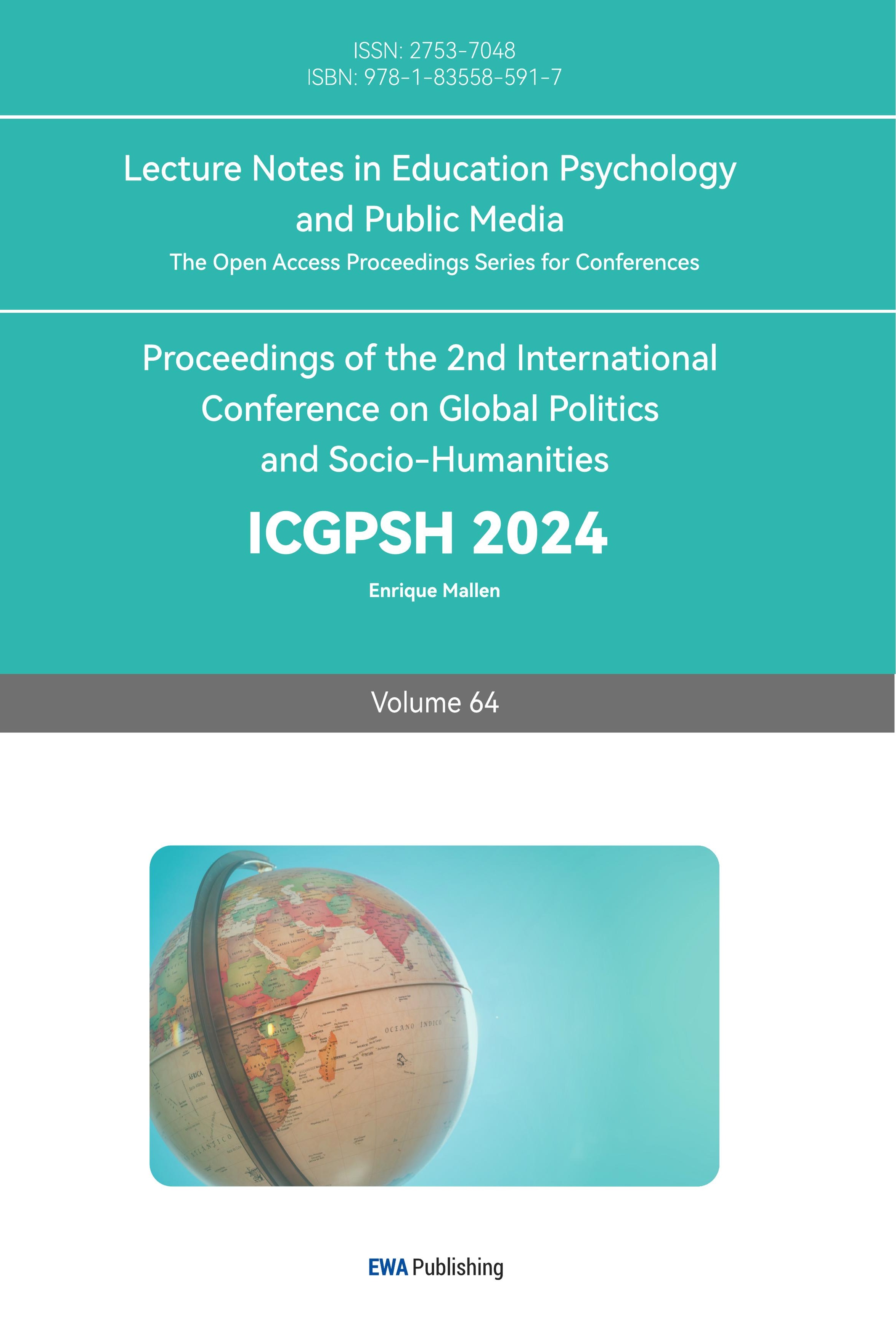1. Introduction
The term “free will” has developed over the past two millennia as the primary descriptor for a significant form of control over one’s actions[1]. The perception of possessing free will, therefore, suggests that one believes they withhold a significant kind of control over their actions. The implications of such beliefs have been shown to influence one’s behaviors and way of perceiving life. Past research has indicated that a belief in free will leads individuals to attribute behavior to internal causes. Evidence supports the intention attribution hypothesis, which predicts that belief in free will relates to higher internal attributions in regards to success and failure, but not the resource hypothesis, which predicts that a higher endorsement in free will belief relates to a lower self-serving bias[2]. Similarly, is has been found that disbeliefs in free will is associated with impulsive, aggressive and even antisocial tendencies[3], indicating a reduction and need for self-control[4]. Conversely, belief in free will correlates positively with life satisfaction and finding life meaningful, with self-efficacy and self-control, and lower levels of stress[4]. However, belief in free will has demonstrated only modest or negligible correlations with other variables, indicating that it is a distinct trait.
Future expectations have also been shown to be more optimistic among individuals who believe in free will. Those with this belief tend to have a more positive outlook on their future, feeling empowered to shape their life path and achieve desired outcomes. This sense of agency fosters optimism about the future and encourages proactive behavior[5]. There is a scarcity in research on how belief in free will correlates with individuals’ views of the present, whether positively or negatively. For this reason, the present study focuses on examining the correlation between optimism and belief in free will. Additionally, research generally explores broader indications of free will beliefs, like self-control, self-efficacy and stress levels, but little attention has been paid to specific areas where these traits might be actively applied. Therefore, this research also investigated the correlation between work motivation and belief in free will.
Many research regarding free will have been done in an exclusively Western sample. This presents a limitation in the current body of work, as the concept of free will, along with the idea of personal freedom, can be significantly influenced by cultural background and religious beliefs [6]. Specifically, Western cultures tend to emphasize the value of free will while devaluing determinism. To address this gap, the present research focuses on a localized sample from China, an Eastern collectivist country, to investigate free will and its implications.
2. Methods
2.1. Participants
A total of 54 employed adults aged, between 30 and 50 participated in this study, recruited through opportunity sampling. The sample was comsisted of 22 males and 32 females, with a mean age of 37.8 years (SD = 6.3). Of the participants, 30% (16 individuals) were employed within the same company in the education and college counseling industry, as they were recruited through a company group chat. The remaining 70% of participants (38 individuals) were drawn from various industries and represented a range of income levels. The inclusion criteria required that all participants be currently employed adults within the specified age range.
2.2. Instruments
The present study utilized a 45-item questionnaire composed of three existing scales: the Free Will subscale of the FAD-Plus[7], the Work Extrinsic and Intrinsic Motivation Scale (WEIMS), and a shortened version of the Optimism and Pessimism Scale (OPS-C). All scales were translated into Chinese using ChatGPT, Google Translate, and native speaker revisions to ensure accuracy and cultural relevance.
2.2.1. Free Will Subscale of FAD-Plus
The Free Will subscale of the FAD-Plus consisted of 7 items assessing participants' beliefs about the concept of free will. Responses were collected on a 5-point Likert scale ranging from 1 (strongly disagree) to 5 (strongly agree). This subscale has demonstrated acceptable reliability in prior research, with Cronbach’s alpha typically above 0.70.
2.2.2. WEIMS
The Work Extrinsic and Intrinsic Motivation Scale (WEIMS)[8] consisting of 18 items, was used to assess participants' overall level of motivation at work. Although the WEIMS is typically used to distinguish between intrinsic, extrinsic, and amotivation, this study focused primarily on amotivation and overall motivation. Higher scores indicated greater levels of motivation. Responses were collected using a 7-point Likert scale (1 = does not correspond at all; 7 = corresponds exactly). The WEIMS has previously shown strong reliability (Cronbach’s alpha > 0.80).
2.2.3. OPS-C (Optimism and Pessimism Scale – Chinese Version)
The Optimism and Pessimism Scale (OPS-C) [9] used in this study was the short form developed by Xia et al. [10]. It consists of 20 items measured on a 4-point Likert scale (1 = strongly disagree; 4 = strongly agree) and assesses participants' levels of dispositional optimism and pessimism. The scale has demonstrated good psychometric properties, with Cronbach’s alpha > 0.75 reported in earlier studies.
2.2.4. Scoring and Reliability
Each subscale was scored by summing responses to relevant items, with higher scores indicating stronger agreement with the construct being measured. For the WEIMS, higher scores indicated greater motivation, emphasizing the contrast between amotivation and general motivation. The reliability of these scales has been well-established in previous research and was confirmed to align with the study’s goals.
2.3. Procedure
Before beginning the survey, participants were informed about the voluntary nature of their participation and were assured that their responses would remain anonymous and confidential. By completing the survey, participants provided their consent for their data to be used for research purposes. The instructions outlined that the survey consisted of three sections: two focusing on individual life perspectives, and one examining work-related attitudes and motivation.
The survey was administered online via SurveyMonkey and distributed through a link. On average, participants spent 5 minutes and 29 seconds completing the 45-item questionnaire. Data were collected anonymously and securely stored, with all ethical considerations, including informed consent and confidentiality, carefully maintained.
3. Results
3.1. Distribution of Free Will Scores
The distribution of participants’ free will scores (N = 54), after including outliers, showed a mean of 19.93 (SD = 3.23) and a median of 20.0, with scores ranging from 13 to 27. The distribution exhibited a slight negative skew (Skewness = -0.26165), indicating a marginally higher frequency of lower free will scores. Additionally, the kurtosis of 0.45242 suggests a distribution slightly more peaked than a normal curve. The overall range of the scores was 14, with a total of 13 unique scores.
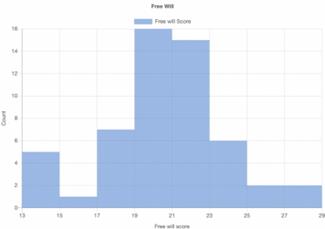
Figure 1: Histogram showing the distribution of free will scores after outliers were included.
3.2. Distribution of Work Motivation Scores
The distribution of participants' work motivation scores (N = 54), after including outliers, showed a mean of 81.85 (SD = 13.13) and a median of 82.5, with scores ranging from 56 to 109. The distribution exhibited minimal skewness (Skewness = -0.08114), indicating a nearly symmetric distribution. The kurtosis was -0.95811, suggesting a slightly flatter distribution than a normal curve. The overall range was 53, with a total of 34 unique scores.
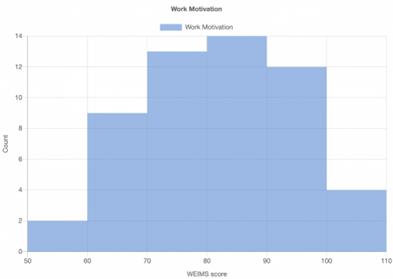
Figure 2: Histogram showing the distribution of work motivation scores.
3.3. Distribution of Optimism Score
The distribution of participants' optimism scores (N = 54), measured by the OPS-C, had a mean of 50.04 (SD = 5.96) and a median of 50.0, with scores ranging from 38 to 66. The distribution showed minimal skewness (Skewness = 0.08639), indicating a nearly symmetrical distribution. The kurtosis was 0.30323, suggesting a distribution slightly more peaked than normal. The overall range was 28, with 21 unique scores.
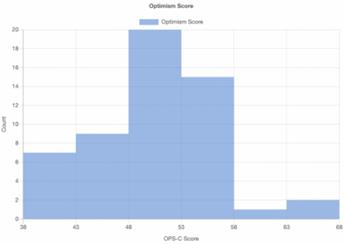
Figure 3: Histogram showing the distribution of optimism scores.
3.4. Correlation Between Free Will and Work Motivation
A Pearson’s correlation was conducted to examine the relationship between free will beliefs and work motivation. The analysis revealed a moderately positive correlation, r = 0.2815, with a coefficient of determination (R² = 0.0792), indicating that approximately 7.92% of the variance in work motivation can be explained by free will beliefs. The correlation was statistically significant (p = 0.039199), suggesting that stronger beliefs in free will are associated with higher work motivation.
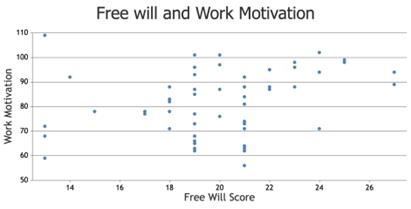
Figure 4: Scatter plot showing the relationship between free will beliefs and work motivation.
3.5. Correlation Between Free will and Optimism
A Pearson’s correlation was also conducted to explore the relationship between free will beliefs and optimism levels. The results showed a weak positive correlation, r = 0.1745, with a coefficient of determination (R² = 0.0305), indicating that only 3.05% of the variance in optimism could be explained by free will beliefs. However, this correlation was not statistically significant (p = 0.206944), meaning that no meaningful relationship was found between free will beliefs and optimism.
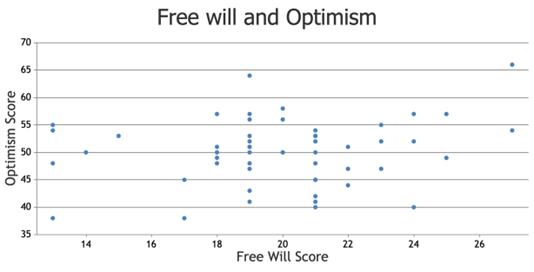
Figure 5: Scatter plot showing the relationship between free will beliefs and optimism.
4. Discussion
4.1. Free Will Belief and Work Motivation
This study explored the relationships between free will beliefs, work motivation, and optimism in a sample of employed Chinese adults. The results revealed a moderate, positive correlation between free will beliefs and work motivation, suggesting that individuals who hold stronger beliefs in free will tend to exhibit higher levels of motivation in their occupation. Beliefs in free will has been linked to autonomy and self-control in previous studies [11]. This correlation could therefore be explained through Self-Determination Theory (SDT). According to SDT, autonomy is a key driver of intrinsic motivation, and belief in free will enhances this sense of autonomy by fostering the perception that one's actions are freely chosen. When employees feel autonomous, they are more likely to be deeply engaged in their work, driven by internal desires for growth and achievement rather than external pressures [12].
Another mechanism for this finding is through goal-setting and self regulation. Belief in free will has been associated with stronger self-regulation [13] and goal-setting behaviors [14]. Employees who believe in their ability to control their actions are more likely to set clear work goals and manage their time and efforts effectively. This sense of purpose and self-control further enhances their motivation to succeed in the workplace. Furthermore, previous research conducted in China has shown that belief in free will predicts perseverance in long-term goals among Chinese adolescents [15], which may be attributed to the increase in motivation driven by this belief.
These results suggest that workplaces that foster a sense of personal autonomy and self-efficacy may boost employee motivation, which could, in turn, improve productivity. This means that HR departments in various industries can focus on creating an environment where employees have greater freedom and ownership over their work. For instance, workers may become more motivated if they have a flexible schedule, or have the occupational freedom to pursue projects that interests them. From a company’s perspective, offering more autonomy to employees may lead to higher employee retention, job satisfaction and reduced turnover rates.
The positive correlation between free will and work motivation can also be leveraged for personal development or life coaching. By focusing on strengthening one’s personal agency through self- reflection and goal-setting, individuals may improve their work habits, relationships, and motivation in various aspects of life.
Future studies should focus on investigating other forms of motivation, such as social motivation or sports motivation, to explore whether free will have the same effects on all forms of motivation.
4.2. Free Will Belief and Optimism
The present study found no significant correlation between free will beliefs and optimism, which contrasts with some prior research in China suggesting that belief in personal control and autonomy is linked to more positive outlooks on life [16]. However, it is important to acknowledge that most research on optimism and free will has been done with high school students in China, whereas the current study focuses specifically on employed adults in a particular age range. Employment-related stress and personal circumstances could affect optimism levels differently than in other populations, potentially diluting the relationship between free will beliefs and optimism. Although prior research has shown a positive relationship between free will beliefs and optimism in Chinese culture, the influence of collectivist values might still moderate this relationship. In a culture that emphasizes interdependence, optimism could be shaped more by social harmony or collective success than by individual autonomy. Thus, even though Chinese individuals can believe in free will, their optimism might be more tied to social factors than personal control.
These results may reflect some implications to well-being programs, encouraging them to focus on other proven factors in order to improve individual’s optimism. Companies or wellness practitioners could design optimism-building programs that focus on elements like social support and emotional regulation, which may more directly impact optimism, instead of fostering autonomy.
Future studies regarding optimism and free will should investigate more dimensions of optimism and how each can relate to free will. Future research could use more comprehensive or multidimensional measures of optimism. For example, some scales, like the Life Orientation Test-Revised (LOT-R) [17], measure optimism as both a general tendency to expect positive outcomes and as a reflection of pessimism. Investigating whether certain dimensions of optimism (such as dispositional optimism vs. situational optimism) relate differently to free will beliefs could provide a clearer picture. Additionally, since optimism can be both a trait (stable personality characteristic) and a state (context-dependent mindset), future studies could explore whether free will is more closely linked to state optimism, which might be influenced by situational factors like life events, rather than a general disposition.
4.3. Limitations
This study has several limitations. The use of opportunity sampling may have introduced availability bias and social desirability bias. Additionally, the sample size of 54 participants may not have been large enough to detect more subtle relationships between the variables. The sample consisted exclusively of employed adults, which may have impacted the findings. Optimism, particularly in the workplace, may be more influenced by job-related factors like stress, workload, or job satisfaction, rather than by abstract beliefs such as free will. Therefore, free will beliefs may have had less impact on optimism in this specific population.
The FAD-Plus scale used to measure free will focuses on philosophical beliefs about free will and determinism, which may not fully capture the practical application of free will in daily life. Similarly, the OPS-C scale measures a broad concept of optimism, but it may not capture domain-specific optimism (e.g., work-related optimism, health-related optimism), which could show a stronger relationship with free will beliefs.
The non-significant result between free will beliefs and optimism (r = 0.1745, p = 0.206944) suggests that, at least in this sample, free will beliefs do not significantly predict optimism. This finding contradicts prior research and could be due to any combination of the limitations discussed above. To better understand this relationship, future studies could focus on exploring moderating variables (e.g., personality traits, cultural influences) and the use of longitudinal designs to see if free will beliefs impact optimism over time, particularly through significant life events or changes in personal circumstances.
5. Conclusion
The present research explores the connection between free will, work motivation and optimism. The paper presents valuable insights into what implications of believing in free will may have on individual’s perception on aspects of their lives. It also shows a need of future research in investigating in other forms of motivation and its link with beliefs of free will. Additionally, the present study calls for an exploration of more dimensions of optimism when exploring it in these contexts.
References
[1]. O’Connor, Timothy and Christopher Franklin, "Free Will", The Stanford Encyclopedia of Philosophy (Winter 2022 Edition), Edward N. Zalta & Uri Nodelman (eds.), URL = <https://plato.stanford.edu/archives/win2022/entries/freewill/>.
[2]. Genschow, O., & Lange, J. (2022). Belief in Free Will Is Related to Internal Attribution in Self-Perception. Social Psychological and Personality Science, 13(8), 1259-1268. https://doi.org/10.1177/19485506211057711 Copy Citation
[3]. Baumeister, R., & Brewer, L. (2012). Believing versus Disbelieving in Free Will: Correlates and Consequences. Social and Personality Psychology Compass, 6, 736-745. https://doi.org/10.1111/J.1751-9004.2012.00458.X.
[4]. Rigoni, D., Kühn, S., Gaudino, G., Sartori, G., & Brass, M. (2012). Reducing self-control by weakening belief in free will. Consciousness and Cognition, 21, 1482-1490. https://doi.org/10.1016/j.concog.2012.04.004.
[5]. Seto, E., Hicks, J. A., Davis, W. E., & Smallman, R. (2015). Free will, counterfactual reflection, and the meaningfulness of life events. Social Psychological and Personality Science, 6(3), 243-250.
[6]. Cracco, E., González-García, C., Hussey, I., Braem, S., & Wisniewski, D. (2020). Cultural pressure and biased responding in free will attitudes. Royal Society Open Science, 7. https://doi.org/10.1098/rsos.191824.
[7]. Paulhus, D. L., & Carey, J. M. (2011). The FAD-Plus: measuring lay beliefs regarding free will and related constructs. Journal of personality assessment, 93(1), 96–104. https://doi.org/10.1080/00223891.2010.528483
[8]. Tremblay, M. A., Blanchard, C. M., Taylor, S., Pelletier, L. G., & Villeneuve, M. (2009). Work Extrinsic and Intrinsic Motivation Scale: Its value for organizational psychology research. Canadian Journal of Behavioural Science/Revue canadienne des sciences du comportement, 41(4), 213.
[9]. Xia, J., Wu, D., Zhang, J., Xu, Y., & Xu, Y. Optimism and Pessimism Scale--Chinese Short Form. Journal of Health Psychology.
[10]. Xia J, Wu D, Zhang J, Xu Y, Xu Y. Chinese version of the Optimism and Pessimism Scale: Psychometric properties in mainland China and development of a short form. J Health Psychol. 2016 Jun;21(6):983-93. doi: 10.1177/1359105314544071. Epub 2014 Aug 7. PMID: 25104781.
[11]. Baumeister, R., Crescioni, A., & Alquist, J. (2011). Free Will as Advanced Action Control for Human Social Life and Culture. Neuroethics, 4, 1-11. https://doi.org/10.1007/S12152-010-9058-4.
[12]. Deci, E. L., & Ryan, R. M. (2012). Self-determination theory. Handbook of theories of social psychology, 1(20), 416-436.
[13]. Feldman, G., Chandrashekar, S., & Wong, K. (2016). The freedom to excel: Belief in free will predicts better academic performance. Personality and Individual Differences, 90, 377-383. https://doi.org/10.1016/J.PAID.2015.11.043.
[14]. Stillman, T., Baumeister, R., & Mele, A. (2011). Free will in everyday life: Autobiographical accounts of free and unfree actions. Philosophical Psychology, 24, 381 - 394. https://doi.org/10.1080/09515089.2011.556607.
[15]. Li, J., Zhao, Y., Lin, L., Chen, J., & Wang, S. (2018). The freedom to persist: Belief in free will predicts perseverance for long-term goals among Chinese adolescents. Personality and Individual Differences, 121, 7-10. https://doi.org/10.1016/J.PAID.2017.09.011.
[16]. Li, C., Wang, S., Zhao, Y., Kong, F., & Li, J. (2017). The Freedom to Pursue Happiness: Belief in Free Will Predicts Life Satisfaction and Positive Affect among Chinese Adolescents. Frontiers in Psychology, 7. https://doi.org/10.3389/fpsyg.2016.02027.
[17]. Glaesmer, H., Rief, W., Martin, A., Mewes, R., Brähler, E., Zenger, M., & Hinz, A. (2012). Psychometric properties and population‐based norms of the Life Orientation Test Revised (LOT‐R). British journal of health psychology, 17(2), 432-445.
Cite this article
Lin,Z. (2024). Free Will, Work Motivation and Optimism. Lecture Notes in Education Psychology and Public Media,64,197-204.
Data availability
The datasets used and/or analyzed during the current study will be available from the authors upon reasonable request.
Disclaimer/Publisher's Note
The statements, opinions and data contained in all publications are solely those of the individual author(s) and contributor(s) and not of EWA Publishing and/or the editor(s). EWA Publishing and/or the editor(s) disclaim responsibility for any injury to people or property resulting from any ideas, methods, instructions or products referred to in the content.
About volume
Volume title: Proceedings of the 2nd International Conference on Global Politics and Socio-Humanities
© 2024 by the author(s). Licensee EWA Publishing, Oxford, UK. This article is an open access article distributed under the terms and
conditions of the Creative Commons Attribution (CC BY) license. Authors who
publish this series agree to the following terms:
1. Authors retain copyright and grant the series right of first publication with the work simultaneously licensed under a Creative Commons
Attribution License that allows others to share the work with an acknowledgment of the work's authorship and initial publication in this
series.
2. Authors are able to enter into separate, additional contractual arrangements for the non-exclusive distribution of the series's published
version of the work (e.g., post it to an institutional repository or publish it in a book), with an acknowledgment of its initial
publication in this series.
3. Authors are permitted and encouraged to post their work online (e.g., in institutional repositories or on their website) prior to and
during the submission process, as it can lead to productive exchanges, as well as earlier and greater citation of published work (See
Open access policy for details).
References
[1]. O’Connor, Timothy and Christopher Franklin, "Free Will", The Stanford Encyclopedia of Philosophy (Winter 2022 Edition), Edward N. Zalta & Uri Nodelman (eds.), URL = <https://plato.stanford.edu/archives/win2022/entries/freewill/>.
[2]. Genschow, O., & Lange, J. (2022). Belief in Free Will Is Related to Internal Attribution in Self-Perception. Social Psychological and Personality Science, 13(8), 1259-1268. https://doi.org/10.1177/19485506211057711 Copy Citation
[3]. Baumeister, R., & Brewer, L. (2012). Believing versus Disbelieving in Free Will: Correlates and Consequences. Social and Personality Psychology Compass, 6, 736-745. https://doi.org/10.1111/J.1751-9004.2012.00458.X.
[4]. Rigoni, D., Kühn, S., Gaudino, G., Sartori, G., & Brass, M. (2012). Reducing self-control by weakening belief in free will. Consciousness and Cognition, 21, 1482-1490. https://doi.org/10.1016/j.concog.2012.04.004.
[5]. Seto, E., Hicks, J. A., Davis, W. E., & Smallman, R. (2015). Free will, counterfactual reflection, and the meaningfulness of life events. Social Psychological and Personality Science, 6(3), 243-250.
[6]. Cracco, E., González-García, C., Hussey, I., Braem, S., & Wisniewski, D. (2020). Cultural pressure and biased responding in free will attitudes. Royal Society Open Science, 7. https://doi.org/10.1098/rsos.191824.
[7]. Paulhus, D. L., & Carey, J. M. (2011). The FAD-Plus: measuring lay beliefs regarding free will and related constructs. Journal of personality assessment, 93(1), 96–104. https://doi.org/10.1080/00223891.2010.528483
[8]. Tremblay, M. A., Blanchard, C. M., Taylor, S., Pelletier, L. G., & Villeneuve, M. (2009). Work Extrinsic and Intrinsic Motivation Scale: Its value for organizational psychology research. Canadian Journal of Behavioural Science/Revue canadienne des sciences du comportement, 41(4), 213.
[9]. Xia, J., Wu, D., Zhang, J., Xu, Y., & Xu, Y. Optimism and Pessimism Scale--Chinese Short Form. Journal of Health Psychology.
[10]. Xia J, Wu D, Zhang J, Xu Y, Xu Y. Chinese version of the Optimism and Pessimism Scale: Psychometric properties in mainland China and development of a short form. J Health Psychol. 2016 Jun;21(6):983-93. doi: 10.1177/1359105314544071. Epub 2014 Aug 7. PMID: 25104781.
[11]. Baumeister, R., Crescioni, A., & Alquist, J. (2011). Free Will as Advanced Action Control for Human Social Life and Culture. Neuroethics, 4, 1-11. https://doi.org/10.1007/S12152-010-9058-4.
[12]. Deci, E. L., & Ryan, R. M. (2012). Self-determination theory. Handbook of theories of social psychology, 1(20), 416-436.
[13]. Feldman, G., Chandrashekar, S., & Wong, K. (2016). The freedom to excel: Belief in free will predicts better academic performance. Personality and Individual Differences, 90, 377-383. https://doi.org/10.1016/J.PAID.2015.11.043.
[14]. Stillman, T., Baumeister, R., & Mele, A. (2011). Free will in everyday life: Autobiographical accounts of free and unfree actions. Philosophical Psychology, 24, 381 - 394. https://doi.org/10.1080/09515089.2011.556607.
[15]. Li, J., Zhao, Y., Lin, L., Chen, J., & Wang, S. (2018). The freedom to persist: Belief in free will predicts perseverance for long-term goals among Chinese adolescents. Personality and Individual Differences, 121, 7-10. https://doi.org/10.1016/J.PAID.2017.09.011.
[16]. Li, C., Wang, S., Zhao, Y., Kong, F., & Li, J. (2017). The Freedom to Pursue Happiness: Belief in Free Will Predicts Life Satisfaction and Positive Affect among Chinese Adolescents. Frontiers in Psychology, 7. https://doi.org/10.3389/fpsyg.2016.02027.
[17]. Glaesmer, H., Rief, W., Martin, A., Mewes, R., Brähler, E., Zenger, M., & Hinz, A. (2012). Psychometric properties and population‐based norms of the Life Orientation Test Revised (LOT‐R). British journal of health psychology, 17(2), 432-445.





